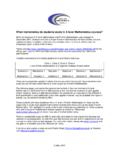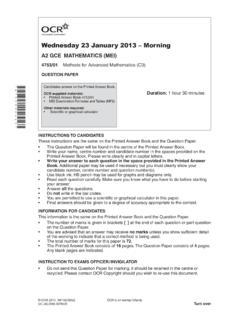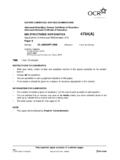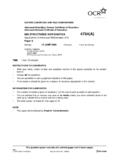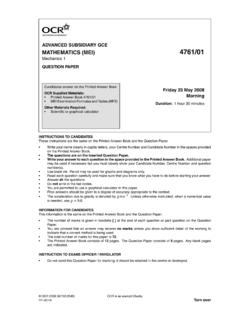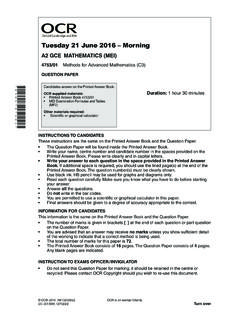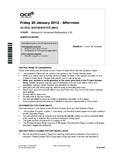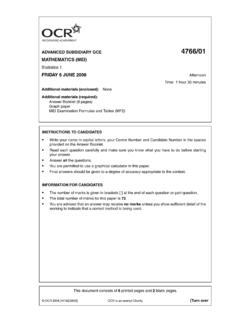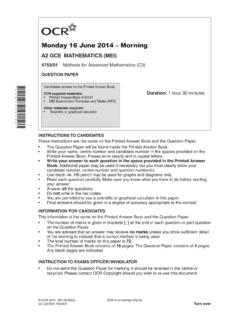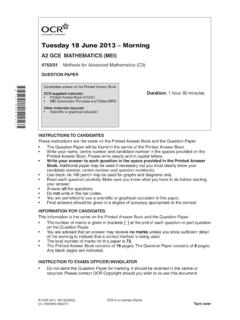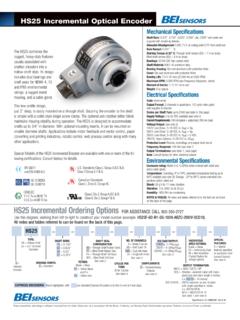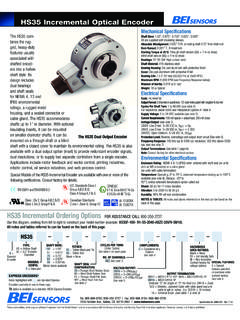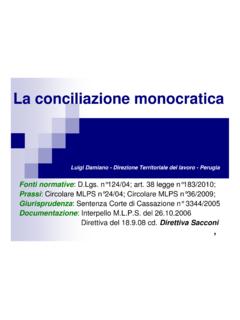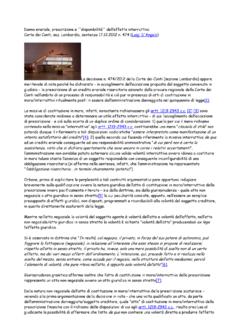Transcription of MATHEMATICS (MEI) 4758/01
1 ADVANCED GCE. MATHEMATICS (MEI) 4758/01 . Differential Equations Candidates answer on the Answer Booklet Monday 24 May 2010. OCR Supplied Materials: Afternoon 8 page Answer Booklet MEI Examination Formulae and Tables (MF2) Duration: 1 hour 30 minutes Other Materials Required: Scientific or graphical calculator *475801*. * 4 7 5 8 0 1 *. INSTRUCTIONS TO CANDIDATES. Write your name clearly in capital letters, your Centre Number and Candidate Number in the spaces provided on the Answer Booklet. Use black ink. Pencil may be used for graphs and diagrams only. Read each question carefully and make sure that you know what you have to do before starting your answer. Answer any three questions. Do not write in the bar codes. You are permitted to use a graphical calculator in this paper. Final answers should be given to a degree of accuracy appropriate to the context.
2 The acceleration due to gravity is denoted by g m s 2 . Unless otherwise instructed, when a numerical value is needed, use g = INFORMATION FOR CANDIDATES. The number of marks is given in brackets [ ] at the end of each question or part question. You are advised that an answer may receive no marks unless you show sufficient detail of the working to indicate that a correct method is being used. The total number of marks for this paper is 72. This document consists of 4 pages. Any blank pages are indicated. OCR 2010 [R/102/2661] OCR is an exempt Charity 2R 9J05 Turn over 2. 1 The equation of a curve in the x-y plane satisfies the differential equation d2 y dy 2. +4 + 8y = 32x2 . dx dx (i) Find the general solution. [10]. The curve has a minimum point at the origin. (ii) Find the equation of the curve. [4].
3 (iii) Describe how the curve behaves for large negative values of x. [2]. (iv) Write down an approximate expression for y, valid for large positive values of x. [1]. (v) Sketch the curve. [3]. (vi) Use the differential equation to show that any stationary point below the x-axis must be a minimum. [4]. 2 (a) (i) Find the general solution of dy + 2y = e 2t . [6]. dt (ii) Find the solution of d . + 2 = y, dt where y is the general solution found in part (i), subject to the conditions that = 1 and d . = 0 when t = 0. [7]. dt (b) The differential equation dx + 2x = sin t dt is to be solved. (i) Find the complementary function and a particular integral. Hence state the general solution. [6]. dx (ii) Find the solution that satisfies the condition = 0 when t = 0. [3]. dt (iii) Find approximate bounds between which x varies for large positive values of t.
4 [2]. OCR 2010 4758/01 Jun10. 3. 3 Water is leaking from a small hole near the base of a tank. The height of the surface of the water above the hole is y m at time t minutes. (i) Consider first a cylindrical tank. The height of the water is modelled by the differential equation dy . = k y, dt where k is a positive constant. The height of water is initially 1 m and after 2 minutes it is m. Find y in terms of t, stating the range of values of t for which the solution is valid. Sketch the solution curve. [10]. (ii) Now consider water leaking from a conical tank. The height of the water is modelled by the differential equation dy . y2 = y. dt Find how long it takes the height to decrease from 1 m to m. [5]. (iii) Now consider water leaking from a spherical tank. The height of the water is modelled by the differential equation dy.
5 (ay y2 ) = y, dt where a is the diameter of the sphere. This equation is to be solved by Euler's method. The algorithm is given by tr+1 = tr + h, yr+1 = yr + h yr . The diameter is 2 m and initially the height is 1 m. Use a step length of to estimate the height after minutes. [5]. (iv) For any tank, the velocity of the water leaving the hole is proportional to the square root of the height of the surface of the water above the hole. By considering the rate of change of the volume of water, derive the differential equation dy . = k y dt for the cylindrical tank in part (i). [4]. [Question 4 is printed overleaf.]. OCR 2010 4758/01 Jun10 Turn over 4. 4 At time t, the quantities x and y are modelled by the simultaneous differential equations dx = 2x 5y + 9e 2t , dt dy = x 4y + 3e 2t . dt d2 x dx (i) Show that 2.
6 + 2 3x = 3e 2t . [5]. dt dt (ii) Find the general solution for x. [8]. (iii) Find the corresponding general solution for y. [4]. Initially x = 0 and y = 2. (iv) Find the particular solutions. [4]. (v) Describe the behaviour of the solutions as t . State, with reasons, whether this behaviour is different if the initial value of y is just less than 2, and the initial value of x is still 0. [3]. Copyright Information OCR is committed to seeking permission to reproduce all third-party content that it uses in its assessment materials. OCR has attempted to identify and contact all copyright holders whose work is used in this paper. To avoid the issue of disclosure of answer-related information to candidates, all copyright acknowledgements are reproduced in the OCR Copyright Acknowledgements Booklet. This is produced for each series of examinations, is given to all schools that receive assessment material and is freely available to download from our public website ( ) after the live examination series.
7 If OCR has unwittingly failed to correctly acknowledge or clear any third-party content in this assessment material, OCR will be happy to correct its mistake at the earliest possible opportunity. For queries or further information please contact the Copyright Team, First Floor, 9 Hills Road, Cambridge CB2 1GE. OCR is part of the Cambridge Assessment Group; Cambridge Assessment is the brand name of University of Cambridge Local Examinations Syndicate (UCLES), which is itself a department of the University of Cambridge. OCR 2010 4758/01 Jun10. GCE. MATHEMATICS (MEI). Advanced GCE 4758. Differential Equations Mark Scheme for June 2010. Oxford Cambridge and RSA Examinations 4758 Mark Scheme June 2010. 1(i) 2 4 8 0 M1 Auxiliary equation 2 2 j A1. CF e 2 x ( A cos 2 x B sin 2 x) M1 CF for complex roots F1 CF for their roots PI y ax 2 bx c B1.
8 Y 2ax b, . y 2a Differentiate twice and 2a 4(2a x b) 8(a x 2 bx c) 32 x 2 M1. substitute 8a 32 M1 Compare coefficients 8a 8b 0. 2a 4b 8c 0 M1 Solve a 4, b 4, c 1 A1. PI + CF with two arbitrary GS y 4 x 2 4 x 1 e 2 x ( A cos 2 x B sin 2 x) F1 10. constants (ii) x 0, y 0 A 1 M1 Use condition y 8 x 4 e 2 x ( 2 A sin 2 x 2 B cos 2 x M1 Differentiate (product rule). 2 A cos 2 x 2 B sin 2 x). x 0, y 0 0 4 (2 B 2 A) B 1 M1 Use condition 2 x y 4 x 4 x 1 e (sin 2 x cos 2 x). 2. A1 Cao 4. (iii) x y oscillates B1 Oscillates With (exponentially) growing amplitude B1 Amplitude growing 2. (iv) y (2 x 1)2 or 4 x 2 4 x 1 B1. 1. (v) B1 Minimum point at origin Oscillates for x<0 with B1. growing amplitude Approximately parabolic for B1. x>0. 3. dy Set first derivative (only) to (vi) At stationary point 0 M1. dx zero in DE.
9 D2 y So 32 x 2 8 y A1. dx 2. d2 y Deduce sign of second y 0 2 0 M1. dx derivative minimum E1 Complete argument 4. 1. 4758 Mark Scheme June 2010. 2(a)(i) IF exp 2dt M1 Attempt IF. e 2t A1. dy e2t 2e 2t y 1 M1* Multiply by IF. dt d 2t (e y ) 1 A1. dx e2t y t A *M1A1 Integrate both sides 6. 2 t [ y e (t A)]. Alternative method: B1. CF y Ee 2t B1. PI y Fte 2t M1. In DE: e 2t ( F 2 Ft ) 2 Fte 2t e 2t F=1 M1A1. y e 2t (t E ) F1. dz (ii) 2 z e 2t (t A). dt I e2t B1 Correct or follows (i). d 2t (e z ) t A M1 Multiply by IF and integrate dt e2t z 12 t 2 At B A1. 2 t z e ( t At B). 1 2. 2. t 0, z 1 1 B M1 Use condition z 2e t ( 12 t 2 At B) e 2t (t A) M1 Differentiate (product rule). t 0, z 0 0 2 B A A 2 M1 Use condition z e 2t ( 12 t 2 2t 1) A1 7. Alternative method: PI x ( Pt Qt 2 )e 2t B1 Correct form of PI. P = A and Q = z e 2t ( 12 t 2 At B) M1A1 Complete method Then as above (b)(i) 2 0 2.
10 CF x Ce 2t B1 CF correct PI x a sin t b cos t B1 Correct form of PI. x a cos t b sin t In DE: a cos t b sin t 2a sin t 2b cos t sin t M1 Differentiate and substitute a 2b 0, b 2a 1 M1 Compare and solve a 52 , b 15 A1. GS x 15 (2sin t cos t ) Ce 2t F1 Their PI + CF 6. (ii) x 0, t 0 x 0 (from DE) M1 Or differentiate 0 15 C M1 Use condition x 15 (2sin t cos t e 2t A1 3. (iii) For large t, x 15 (2sin t cos t ) 1. 5. 5 sin (t- ) M1 Complete method So x varies between 1. 5. 5 and 1. 5. 5 A1 Accept x 15 5 2. 2. 4758 Mark Scheme June 2010. y dy kdt 12. 3(i) M1 Separate and integrate 1. 2 y kt B. 2. A1 LHS. A1 RHS. t 0, y 1 2 B M1 Use condition t 2, y 2k 2 M1 Use condition k A1. 1. y 2 1 y (1 )2 A1. Valid for 1 0 , t 20 B1 on arithmetical error in k y B1 Shape 1. B1 Intercepts 20 t 10. y dy 3. (ii) 2. M1 Separate and integrate 5.)
